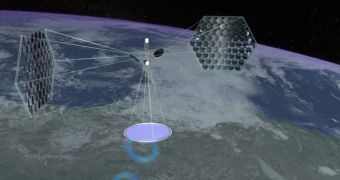Space-based solar power could become a reality soon, if plans to deal with the emerging global energy crisis are developed in time. The world is gradually starting to reach Peak Oil, and governments need to plan ahead to prevent shortages.
The alternative forms of energy production that we currently have, such as for example solar panels, wind farms, geothermal and marine power plants, cannot produce sufficient amounts of electricity.
On the other hand, using nuclear energy is very dangerous, and also expensive. Nuclear fusion is the best possible alternative, but practical applications are still a couple of decades away.
Space experts say that orbit-based solar power plants could be the way to go in producing the required amounts of energy. The plants would basically be satellites capable of beaming sunlight down to Earth in a focused beam.
The former president of India A.P.J. Kalam and representatives from the nonprofit group National Space Society announced the new proposal at a press conference on Thursday, November 4.
The Kalam-NSS Energy Initiative has the potential to transform Earth into a “clean planet, a prosperous planet, and a happy planet,” officials from the two organizations told reporters.
They explained that the system would work in a fairly straightforward manner. Large solar panel would collect solar energy, which would then be focused in a microwave beam, and sent to special facilities on Earth, which would convert the beams into electricity.
The power would then be fed into the power grid normally. A large fleet of satellites could easily cover a large portion of needs, given that collecting sunlight is more efficient in space. Satellites can follow the Sun at all times.
On Earth, solar energy production is hampered by clouds and night. For periods ranging from 8 to 14 hours per day, plants do not work because there is no Sun to fuel them. Storms and cloudy days reduce output even further.
Even if it cannot replace established forms of producing electricity, the new method could augment them. This is very important, given that estimates show the world will need about 87 percent more energy than it does today by 2035.
The orbital technology “produces virtually no carbon dioxide, therefore it's a very clean, renewable energy source,” says the chair of the executive committee at the National Space Society, Mark Hopkins.
“One of the critical things to keep in mind regarding this capability is that it has enormous promise to deliver power globally – power that would be very green – but also that we're not quite ready to do it yet,” adds the president of the Space Power Association, John Mankins.
“It is known that such a proposal can become reality only if the cost of launching satellites into outer space is made economical,” concludes the director of the Indian Space Research Organization (ISRO) Satellite Center, T.K. Alex, quoted by Space.

 14 DAY TRIAL //
14 DAY TRIAL //